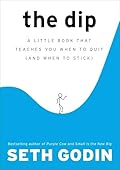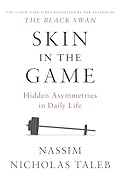
Your Backup Plan Is Why Your Main Plan Keeps Failing
By Derek Neighbors on November 26, 2025
For years, Gangplank had a backup plan we never talked about.
We kept it small enough that our other company, Integrum, could fund it if things went sideways. No real risk. If the community experiment didn’t work out, we’d just absorb the loss and move on. That safety net let us “experiment” for years without ever truly committing.
We told ourselves we were being smart. Responsible. Building slowly.
The truth? We were hedging. And hedging kept us small.
Then we decided we wanted to do something real. We partnered with the city and bought a building that needed massive remodeling. Not a small space Integrum could cover. A commitment too big for the backup plan to save us.
There was no turning back. We literally mortgaged the future. The safety net we’d relied on for years couldn’t catch us anymore. If this failed, it wasn’t a write-off. It was a catastrophe.
And something shifted.
When the backup plan couldn’t save us, we stopped having conversations about whether this would work. We started having conversations about HOW to make it work. The energy changed. The intensity changed. The commitment became real because there was no alternative.
Your backup plan isn’t protecting you. It’s sabotaging you. Every escape route you build is a guarantee that when things get hard enough, you’ll use it.
The Pattern We Don’t Talk About
We disguise fear as prudence. Call hedging “being smart.” Frame optionality as strategic flexibility.
But the Stoics understood something we’ve forgotten: Real commitment is singular. Prohairesis, the Greek concept of moral choice, isn’t about keeping options open. It’s about closing doors.
The business with a backup plan never gets the same intensity as the business that’s your only option. The relationship you’re hedging never gets your full presence. The goal you’re “testing” never gets the obsessive focus that breaks through.
We say we want extraordinary outcomes, then build ordinary commitment. We claim we’re “all in” while maintaining elaborate exit strategies. We wonder why we’re stuck while actively building the architecture of our own retreat.
This applies whether you’re hedging a startup or hedging the decision to leave a toxic job. Whether you have resources or you’re building from nothing. The test is the same: Would you behave differently if the backup plan didn’t exist? If yes, it’s undermining you.
The Responsible Hedge
The entrepreneur who won’t quit consulting until the business is “stable.” The writer who won’t quit their job until the book deal is “certain.” The leader who won’t commit to the transformation until success is “guaranteed.”
You’re not being responsible. You’re engineering your own half-commitment.
The day job isn’t a safety net. It’s a promise to yourself: “When this gets too hard, I have permission to quit.”
Marcus Aurelius wrote extensively on prohairesis, the faculty of choice. The Stoics understood that real power comes from singular commitment to what’s truly within your control. Hedging isn’t controlling risk. It’s guaranteeing mediocrity.
Every backup plan is a pre-negotiated surrender. You’re not preparing for failure. You’re making it inevitable.
The Strategic Flexibility Lie
Keeping multiple options open. “Diversifying.” Not “putting all eggs in one basket.” Framing optionality as sophistication.
The leader who won’t commit to a strategy because they want to “preserve flexibility.” The creator with seventeen different projects “in case one doesn’t work.” The person “exploring options” instead of committing to a path.
Optionality sounds strategic. It’s actually paralysis cosplaying as prudence.
True strategic advantage comes from intensity of focus, not breadth of options. Epictetus taught that prohairesis is strengthened through constraint, not option proliferation. The more escape routes you maintain, the weaker your commitment becomes.
Singular focus isn’t reckless. It’s the only path to excellence.
You’re not staying flexible. You’re ensuring you never commit fully enough to break through. Intensity requires constraint.
The Validation Requirement
“I’ll go all-in once I see some traction.”
Requiring proof before commitment. Making full intensity contingent on external validation. The creator who won’t commit until they have an audience. The founder who won’t quit the job until revenue is “stable.” The leader who won’t transform the team until they see “buy-in.”
Here’s what nobody tells you: Requiring validation before commitment guarantees you never break through the validation threshold.
The commitment level that creates traction IS the all-in commitment you’re withholding. Prohairesis means choosing based on principle, not contingent on outcomes. Waiting for external proof before internal commitment is backwards.
The commitment creates the traction. Not the other way around. Full intensity attracts resources. It creates momentum. It forces you to solve problems you’d otherwise abandon. People can see the difference between someone testing an idea and someone who has no choice but to make it work. That visibility creates opportunities the hedger never gets.
You’re waiting for permission to commit that will never arrive. The validation you need comes AFTER the commitment you’re avoiding.
The Comfortable Suffering
Staying in the “building toward” phase indefinitely. Perpetual preparation. Permanent “transition.”
The entrepreneur in year five of “building while maintaining stability.” The leader still “testing the waters” after 18 months. The transformation that’s “in progress” indefinitely.
You don’t have a backup plan. You have a preferred plan disguised as a fallback. You’re not transitioning. You’re permanently hedging.
The “building toward” phase is actually the destination you’ve chosen.
The Stoics taught that true choice requires accepting consequences. Perpetual hedging is refusing to choose. You’re suffering the stress of building something new while denying yourself the intensity that makes it work.
You’ve built a life of permanent transition where nothing has to fully succeed or clearly fail. It’s the most expensive form of stagnation.
What Actually Works
Real commitment feels reckless to everyone watching. It’s not reckless. It’s the only approach that actually works.
Closing doors creates anxiety because it eliminates escape routes. All-in feels dangerous because it forces you to make it work or visibly fail.
That building became the catalyst for everything Gangplank became. Not because the strategy was brilliant. Not because the timing was perfect. Because the backup plan was gone.
When Integrum couldn’t save us anymore, we showed up differently. We figured things out because figuring it out was the only option.
The years of keeping Gangplank “small enough to fail safely” taught us almost nothing compared to what we learned in the first six months after eliminating the escape route.
Constraint created the intensity. When retreat isn’t an option, you solve problems you would have abandoned. You push through resistance you would have walked away from. The constraint doesn’t just feel different. It changes what you’re capable of.
If you want to stop hedging:
Identify your hedge. Where are you keeping escape routes open? What’s your “just in case” plan? Be honest about the safety net you’ve never acknowledged.
Name the real fear. What are you actually afraid of? Not “failure.” Specifically. Public humiliation? Financial ruin? Being wrong? Name it.
Close the door. Actually eliminate the backup. Not “reduce time on it.” Close it. Create real constraint. Make the only direction forward.
Commit to the timeline. Give yourself a realistic horizon, 12-24 months minimum, where the only option is making it work. Not “trying it out.” Committing to solving it.
One caveat: The Greeks distinguished phronesis (practical wisdom) from prohairesis weakness. Wise contingency planning doesn’t undermine your commitment. The test is whether your backup plan changes how you show up. If you’d fight harder, solve more creatively, and persist longer without the safety net, it’s not wisdom. It’s fear you’ve relabeled.
And yes, you might close the wrong door. That’s a real risk. But perpetually hedging guarantees you never find out which door was right. The risk of commitment is possible failure. The risk of permanent hedging is certain mediocrity.
The Test
Ask yourself these questions honestly:
If your backup plan disappeared tomorrow, would you panic or feel liberated?
How much mental energy do you spend maintaining optionality instead of intensifying commitment?
What would you do differently if the escape route didn’t exist?
Are you building something or testing something?
Would you behave differently if this was your only option?
Final Thoughts
The Stoics knew what modern advice forgets: Commitment isn’t hedged. Prohairesis is singular. Excellence requires constraint, not optionality.
Your backup plan isn’t making you safe. It’s making you mediocre.
Hedging isn’t just bad strategy. It’s a character disorder. The refusal to stake your identity on a chosen path.
Close one door this week. Actually close it. Pick the backup plan that’s draining your commitment and eliminate it. Not reduce it. Close it.
Then watch what happens to your intensity on the main thing.
Marcus Aurelius faced the weight of empire. Epictetus faced slavery. Neither hedged their commitment to virtue with backup plans. Prohairesis was singular. Excellence was unconditional.
You’re not facing Rome. You’re facing a decision about whether your comfort matters more than your potential.
Choose.
Building singular commitment is hard when everything around you encourages hedging. MasteryLab creates the accountability structure for going all-in: daily progress tracking, community support for when the intensity gets uncomfortable, and a framework for maintaining focus when escape routes look tempting. If you’re ready to stop hedging and start committing, join the community.



